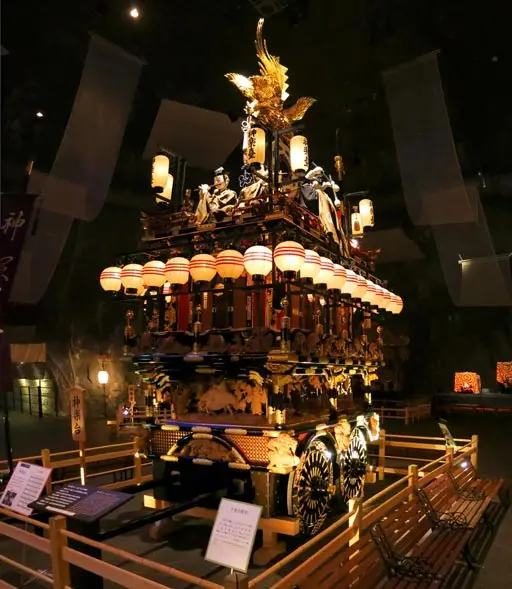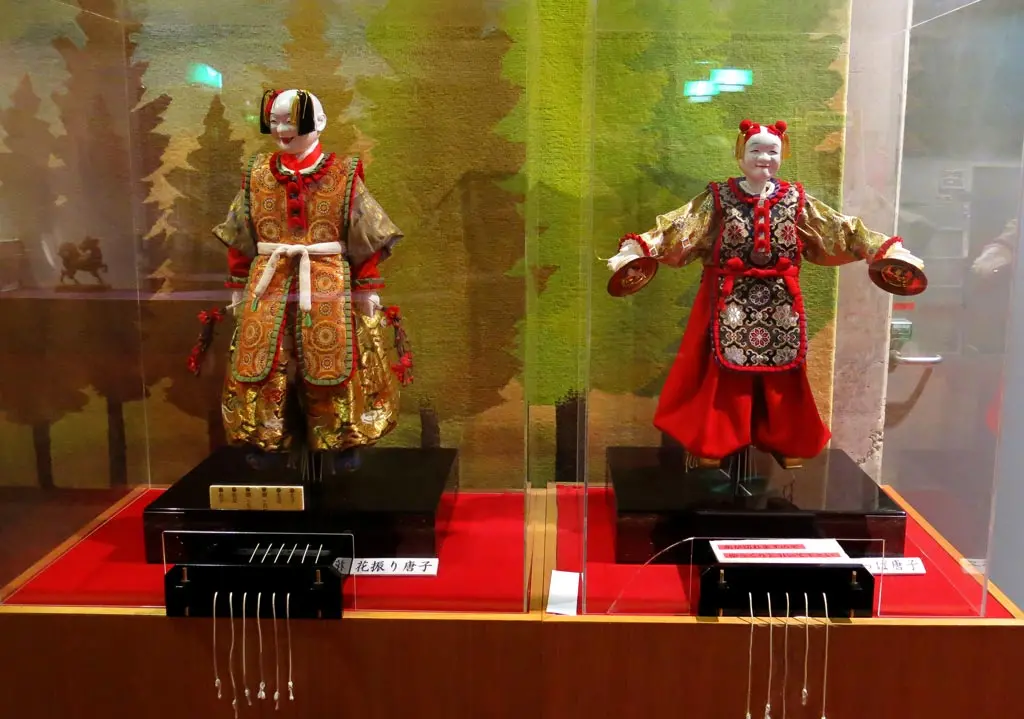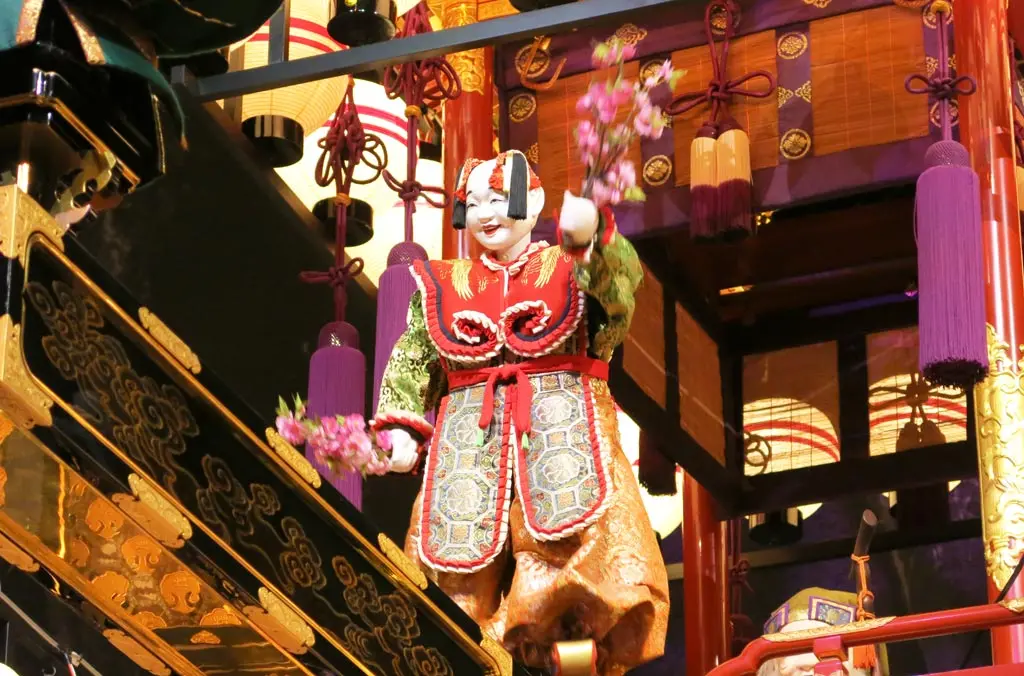Takayama City is probably most well known for its bi-annually festival. Thousands of people come from around Japan, and around the world to view the beautiful festival floats, or yatai, as they are display during the day, and paraded through town at night. I attended the Spring festival this year, and took a bunch of pictures. You can view those here: April 17th, 2014.
But, if you aren't able to make it to the festivals, there are 2 museums in town that showcase festival floats, and you can view them anytime throughout the year. There's the Takayama Festival Float Museum (高山祭屋台会館), or Yatai-kaikan for short. And there's the Hida Takayama Festival "Forest" (飛騨高山まつりの森), or simply Matsuri no Mori.

森 or mori, means forest in Japanese, though this museum really isn't a forest. Even the plaque outside the building says, "Takayama Matsuri Museum." It's located on the south end of town, and sits next two several other museums. There's the tea ceremony museum, and a butterfly and insect museum. There's also a playground in the forest behind the museums. Maybe that's where the forest name comes from.
But, this place is definitely way more animated than a typical Japanese museum. And while it looks very very small from the outside, the whole museum is actually house inside of an expanded geo-dome found in the hill.
As shown below, there's a long hallway dug into the mountain leading to the geo-dome.



Along the left-side of the hallway leading to the geo-dome are miniature scale replicas of the 11 floats featured in the Autumn Takayama Festival.
On the right-side, there's some information showing how this museum was built. There's also information about festival floats and which festivals actually use and display floats. Apparently, there's only 6 festivals in Japan that actually use these kinds of floats.
There's the Takayama Festival 高山祭 and the Furukawa Festival 古川祭. Both of which are (basically) where I live in Gifu, Japan. Up north, there's the Takaoka Kuruma-yama Festival 高岡御車山祭. In Kyoto, their Gion Festival 京都祇園祭 uses them too. To the west of Tokyo in Saitama, the city of Chichibu has a Night Festival 秩父夜祭 with floats. Apparently, that one has fireworks, too. :) And finally, there's the Hitachi Nagaremono Festival? 日立風流物祭. I dunno. Anyway, that's what the signs say.
Along with that information, there are some beautiful golden-lacquered folding screens depicting these festivals. The Takayama Festival is in the photo above.
As you proceed down the hallway, you enter the geo-dome, which houses 6 floats.
According to the brochure, these 6 floats are sometimes rotated with other floats. The float on display this year were the following, starting from the middle and going clockwise from the entrance: Kaguratai, Garyuutai, Ryuuoutai, Fukujuutai, Kintokitai, and Kinkeitai.
Most of the following text is from the plaques displayed next to the floats

Kaguratai always leads the procession, accompanied by "Michi-yuki," a traditional Japanese musical piece. The large Japanese drum hanging from the top level of the float, with a diameter of 80 cm, calls out the order to start the procession. There is an Inami carving, made from a single zelcova (Keyaki) tree, attached to the base of the float. Also, the harmonization of lacquer and gold ornamental fittings makes this float especially exquisite.

Ryuuoutai also didn't have a plaque. But, Ryuuou literally translates as Dragon King.

Because Fukujutai gets its name from two gods (Fukurokuju and Jurojin) of the Seven Gods of Happiness, the float carries the meaning of undying youth. There is a carving made from a single zelcova (Keyaki) tree with no lacquer, of the Seven gods of Happiness and the image of Chinese children, called Karako. There is a tapestry, embroidered with gold thread, of Daikokusama (one of the seven gods) with several straw sacks of rice, and Karako on the back of the float. Also, two marionettes Jurojin and Karako, perform on the top level.

Kintokitai gets its name from its owner, Kinta Nakada (President of Matsuri no Mori). He envisioned a float that is "Not only for adults, but, one that children could enjoy as well." This float was designed with a four-layer structure; something not traditionally seen in Takayama Festival floats. Its main characteristic is its heavy and sturdy build. The marionette, positioned on the top level, was made by a Nagoya doll maker (Yorozuya, Nihei). This marionette will be shown off and on during museum hours.

The rooster on the top of Kinkeitai is a messenger from Ise Shrine. There is a cock and a hen with three chicks. Being that the rooster possesses the Five Virtues of "Wisdom, Fighting, Spirit, Courage, Benevolence and Trust," as well as "Family Safety," "Martial Happiness", and "Fruitfullness", this float is an expression of the ideal family. There is a carving in the shape of a lattice located in the middle and lower levels of the float. The curtain with a golden cock and peony design on the back of the float, is made with woolen cloth and embroidered with gold and silk thread.
About every 10 minutes in Matsuri no Mori, the lights dim down, and several spotlights focus on a particular act. There are 7 different acts and they perform once every hour. Here's the following schedule with 9 o'clock as an example:
神楽台 / Kaguratai // 9:00 - 9:04
夫婦獅子 / めおとじし / Shishi // 9:08 - 9:15
銭太鼓 / ぜにだいこ // 9:15 - 9:18
金時台 / Kintokitai // 9:23 - 9:27
福寿台 / Fukujutai // 9:30 - 9:35
世界一大太鼓 / 9:40 - 9:45
金鶏台 / Kinkeitai // 9:50 - 9:55
I arrived at the museum in the middle of the Zenidaiko dancing, so I was only able to view the last 4.
As mentioned, in previous articles about festival floats, one of the main attractions of the float are the marionettes attached, and the complicated dances they perform. Each float's marionette's dance is meant to tell some kind of story and really highlight the meaning behind the float.
The following photos are from Kintokitai, Fukujutai, and Kinkeitai.



The Kintokitai dance features a boy either attacking or warding off a bear on the very end of the float. He dances and spins around, and at the end the bear (or the spirit of the bear) is defeated.
The Fukujutai dance features a man walking towards a peach and performing its dance. He moves around, then a man with a cannon emerges from the peach. That man moves around then fires a bunch of confetti out of the cannon into the crowd.
The Kinkeitai dance is a little more tame and simple. It just features the marionette moving to the end of the float, dancing. Then the man turns into a demon, and continues to dance. Then he turns back into a human, and completes the dance.
Also, I watched the 世界一大太鼓, or The World's Largest Giant Taiko Drum performance. 3 marionettes turn to the drums, and begin beating a song. It's a little creepy since these marionettes are life size, and they bow before and after the performance, which is a very "human" Japanese thing to do.
Overall, I really like the museum. I think it shows off the Festival floats and marionette dances really well, and in a unique atmosphere, too. Though, I think it's just one step away from a Chucky Cheese, or Shony's Pizza Place. It's all very animatronic, and the spotlights really focus your attention. There's an announcer that always says what's going on, and how long before the next performance.
Also, inside the museum is a Crystal Cave, which was closed for some reason. Maybe it's only open on the weekend, or something.
Matsuri no Mori is a bit expensive, too, at 1000円. I think by American standards, that's not too bad, but Japanese museums are usually half that price. Of course, those museums lack that flare, and experience built into Matsuri no Mori. This museum is very hands-on, and let's you have fun. It might be worth the price if there's some kind of package deal that includes all the other museums in the area for a discount price.
But, I dunno. I thought it was neat, and there was plenty of good information. It's certainly more interesting than the Yaitai-kaikan.























